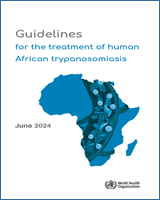Overview
Human African trypanosomiasis (HAT), or sleeping sickness, is a parasitic infection that is endemic in sub-Saharan Africa and is almost invariably fatal unless treated.
The infection is transmitted to humans through the bite of an infected tsetse fly. The parasite multiplies in the lymph and blood, causing unspecific symptoms and signs (first-stage or haemo-lymphatic stage) and, over time, crosses the blood–brain barrier to infect the central nervous system (second-stage or meningo-encephalitic stage). Brain involvement causes various neurological disturbances, including sleep disorders (hence the name “sleeping sickness”), progression to coma and, ultimately, death.
The disease has two forms: the slowly progressing form (gambiense HAT), caused by infection with Trypanosoma brucei gambiense, found in western and central Africa (92% of cases in 2018–2022); and the more rapidly progressive form (rhodesiense HAT), caused by infection with T. b. rhodesiense, in eastern and southern Africa (responsible for the remainder of cases). All age groups and both sexes are at risk of both forms of HAT, although prevalence is higher in adults than in children.
The incidence of the disease has strongly declined in response to intensive surveillance and control interventions in endemic areas. As a result, HAT is among the neglected tropical diseases targeted for elimination by the World Health Organization (WHO).
The remarkable progress in the control of gambiense HAT has relied on case-finding and curative treatment, which interrupts transmission by depleting the reservoir of parasites in humans. This has been combined in some areas with vector control activities. In contrast to gambiense HAT, treatment of rhodesiense HAT patients has little impact on disease transmission, but it is certainly life-saving.
The WHO interim guidelines for the treatment of gambiense HAT, issued in 2019 added as a therapeutic option the new medicine fexinidazole. Thanks to its recent extension of indication, fexinidazole is now also recommended for treatment of rhodesiense HAT. The present guidelines incorporate all these changes, leading to a substantial reconfiguration of therapeutic choices for both disease forms.
HAT is a serious, life-threatening disease and the efficacy of fexinidazole depends on swallowing the medicine after an appropriate intake of food as well as on completing the full 10-day treatment schedule. Therefore, the recommendations regarding fexinidazole administration are considered key elements that must be carefully followed. When the conditions listed in these guidelines are not met for any individual patient, the alternative available treatments should be prescribed.
General disclaimers. The designations employed and the presentation of the material in this publication do not imply the expression of any opinion whatsoever on the part of WHO concerning the legal status of any country, territory, city or area or of its authorities, or concerning the delimitation of its frontiers or boundaries. Dotted and dashed lines on maps represent approximate border lines for which there may not yet be full agreement.
The mention of specific companies or of certain manufacturers’ products does not imply that they are endorsed or recommended by WHO in preference to others of a similar nature that are not mentioned. Errors and omissions excepted, the names of proprietary products are distinguished by initial capital letters.
All reasonable precautions have been taken by WHO to verify the information contained in this publication. However, the published material is being distributed without warranty of any kind, either expressed or implied. The responsibility for the interpretation and use of the material lies with the reader. In no event shall WHO be liable for damages arising from its use.

